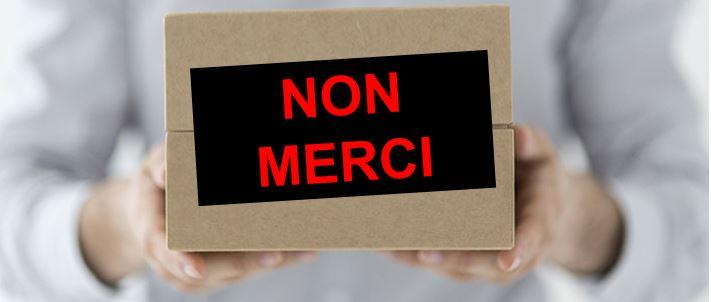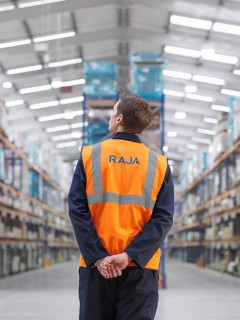Like all e-tailers and retailers, you have already seen the increase in order returns year after year. It is therefore time to think about a robust returns policy. Do you plan to go even further in your “returns” strategy? Christophe Leroy, e-trade logistics & transport director, shares his thoughts with you.
What elements should be taken into account to define a financially controlled return policy?
- We’re talking here about parcel logistics from 0 to 30 kg. For bulky products, it’s a bit different.
- I am also excluding after-sales returns, which are also a special case.
 ROI means costs first We cannot talk about costs without first thinking about the experience that we want to give our customers. The choices made on this “customer experience” aspect will have an impact on the “costs” aspect
ROI means costs first We cannot talk about costs without first thinking about the experience that we want to give our customers. The choices made on this “customer experience” aspect will have an impact on the “costs” aspect
-
What kind of customer experience should be offered for returning an order?
-
What are the costs of returning an order?
What convenience do you want to offer at the time of return?
Think about reducing the possible constraints for the customer as much as possible
for example, in the case of returns to relay points, during a product exchange (e.g. change of product size), it may be interesting to synchronise the delivery of the replacement product and the collection of the product to be exchanged(swap process, already used by telephone operators).In this way, the customer only has to make one trip, and – even if this may be a joke – he always has a product in his possession, so he is naturally more reassured!Another example of an approach to facilitate the customer experience: offer to collect the product to be exchanged, instead of asking the customer to drop it off at a relay point
Think omni-channel and align your logistics processes
in 2018, the customer is not at all aware (nor does he have to be!) of the information system problems that such an organisation may pose (different information systems between the web and the shop, for example), so he will accept even less if this convenience is refused!
Reduce the return transport time perceived by the customer
in the case of “web” returns, the delays in traditional transport networks (relay, in particular) can be quite long (1 to 2 weeks, or even longer). One solution may be to trigger the desired action (substitute product, refund) as soon as the parcel is picked up from the relay point
Is your business adapted to Try then pay?
[Following the example of what Zalando has been offering in France for some time, or ASOS in the United Kingdom, and more generally most German e-tailers for a long time, the“try on then pay” principle is developing. This removes a barrier to purchase for the customer! On the other hand, for the e-tailer, this assumes a well-honed organisation: dispatch of products without associated payment, outgoing and incoming products not available for sale, higher rate of product returns, post-delivery payment incidents, etc.
2. The costs to be taken into account
the cost of transport: this is the cost of return transport, then outward transport of the substitute product, if necessary. This cost can take on enormous proportions, particularly in the case of cross-border flows. In this case, it may therefore be advisable to sort and store the return products that can be remarketed locally, to limit the cost of re-shipment. To this must be added the loss of parcels during transport, which is more frequent in the return flow than in the outward flow.The cost of logistical processing of the product: sorting, possible re-conformity (repacking, etc.), restockingThe possible loss linked to downgrading to second choice or even destruction (partial or total discount, remarketing/destruction circuit), in the case of products returned in a condition that does not allow them to be resold as new products […]Read our tips for reducing order returns]
tous ces coûts peuvent être d’autant plus importants que le e-commerçant souhaite faciliter la vie du client ! (Voir mon premier point « praticité pour le client »)
“Le problème des retours – de surcroit lorsqu’il est offert – c’est le coût qu’il représente pour le E-commerçant : affranchissement, suivi client, vérification, traitement informatique. Si certains frais sont difficilement compressibles, le E-commerçant peut faire la différence en s’organisant efficacement : anticiper et automatiser au maximum la gestion de ses retours. Par exemple, en mettant en place des systèmes de veille pour connaître chaque jour, quels seront les retours qui arriveront demain dans l’entrepôt et leur origine !”
Florian Cimetierre, co-fondateur d’ITinSell
Conclusion ?
Si l’on souhaite calculer un ROI sur le sujet “retour”, il est très difficile de mettre un gain en face. En effet, il est virtuellement impossible (sauf à avoir une audience énorme, et à faire de l’A/B testing poussé, par
In short, a return strategy is a gamble!
- A bet that the customer will see the brakes on purchasing lifted (hence an improvement in the conversion rate),
- A bet that the customer will return to your site because they had an outstanding buying experience (hence an improvement in the eventual repeat rate).
- To this, we can add possible positive effects in terms of notoriety, because possible innovations on the subject of “return” allow e-tailers to communicate, by differentiating themselves from their colleagues! (Cf. the declarations of Jonathan Trépo, DG France of Zalando, on their “return” strategy)
This is a gamble worth taking, as long as it fits in with your overall strategy: acquisition, re-assurance, awareness, costs, etc
 Read also: the performance criteria of a proactive return strategy by Eddy Richauvet from ShopRunBack
Read also: the performance criteria of a proactive return strategy by Eddy Richauvet from ShopRunBack

About the author
 Christophe Leroy was the logistics and transport director of Motoblouz.com, the French leader in motorbike and scooter equipment on the Internet (around 400,000 units shipped in 2017). He has just joined the logistics consultancy Suppleo
Christophe Leroy was the logistics and transport director of Motoblouz.com, the French leader in motorbike and scooter equipment on the Internet (around 400,000 units shipped in 2017). He has just joined the logistics consultancy Suppleo














